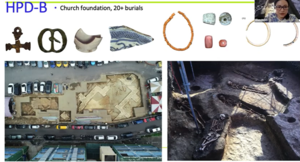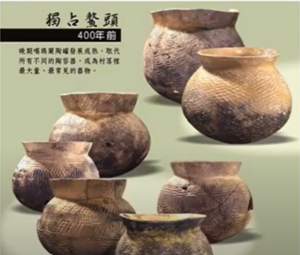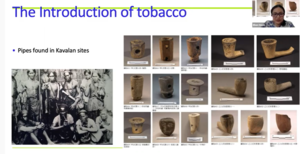Unveiling the protohistory of northern Taiwan: The archaeology of the Basay and Kavalan



Date :
2022-07-12
Department :
International College of Innovation
【Article by International College of Innovation】
The northeastern part of Taiwan had a more vibrant past than generally acknoweledged with plains indigenous peoples actively trading with each other and possibly taking part in the East Asian maritime trade. Furthermore, rather than passive subjects of the Spanish colonial invaders in the 17th century, they were able to capitalize on their cultural and geographical strength to maintain their distinctiveness and indigeneity. This can be gleaned from archeological evidence in two sites: that of the Basay in Heping Island near present-day Keelung on the northeastern coast of the country and a bigger site of the Kavalan in the Yilan plain in present-day Xinshe and Hualien.
On May 4, 2022, Dr. Ellen Hsieh, Assistant Professor at the Institute of Anthropology, National Tsing Hua University, presented data from these sites to an audience of students of the NCCU International Program of Austronesian Studies and UCLA. Heping Island contains Basay sites including the Todos Los Santos Church and a Basay settlement. A third site, Fort Salvador, has not been excavated because it is currently a shipyard. Since 2012, there have been four digs in the location of the church, unearthing various artefacts used by the Spanish and over 20 human remains buried there. One female skeleton was buried differently from all others, lying perpendicular with the rest and wearing indigenous jewelry. Dr. Hsieh said that her burial preceded the rest, showing that the Spanish built the church over a burial place or a sacred ground. Digs have also been conducted on Basay indigenous settlement showing eight layers starting from the Early Iron Age (2000-1200 BP).
In the Kavalan site, the finest artifacts unearthed were intricately made pottery and a decorative wire decoration called the “golden carp” made from materials in the region. Imported goods like glass beads, carnelian beads, and Chinese pottery were also found. The presence of imported goods shows the role of the Basay people as notable traders, facilitating exchanges between foreigners like the Spanish and Chinese and indigenous peoples like the Kavalan, as has been documented by Japanese historians. But while the Kavalan people consumed these imported goods, there was little evidence of cultural transformation, according to Dr. Hsieh. Instead, the beads and jars were incorporated into their culture. The Kavalan site also unearthed plenty of smoking pipes. The Spanish had introduced tobacco in Asia and pipe-smoking among Formosan groups has also been documented by the Japanese.
In conclusion, Dr. Hsieh said that the sites reveal pericolonialism similar to that of the Ifugaos of the Philippines wherein contrary to Spanish claims of full colonization, the indigenous peoples were actively shaping and reshaping their destinies with the Kavalan, consuming foreign goods but retaining their cultures and wherein the converted Basay played the role of middlepersons.
The northeastern part of Taiwan had a more vibrant past than generally acknoweledged with plains indigenous peoples actively trading with each other and possibly taking part in the East Asian maritime trade. Furthermore, rather than passive subjects of the Spanish colonial invaders in the 17th century, they were able to capitalize on their cultural and geographical strength to maintain their distinctiveness and indigeneity. This can be gleaned from archeological evidence in two sites: that of the Basay in Heping Island near present-day Keelung on the northeastern coast of the country and a bigger site of the Kavalan in the Yilan plain in present-day Xinshe and Hualien.
On May 4, 2022, Dr. Ellen Hsieh, Assistant Professor at the Institute of Anthropology, National Tsing Hua University, presented data from these sites to an audience of students of the NCCU International Program of Austronesian Studies and UCLA. Heping Island contains Basay sites including the Todos Los Santos Church and a Basay settlement. A third site, Fort Salvador, has not been excavated because it is currently a shipyard. Since 2012, there have been four digs in the location of the church, unearthing various artefacts used by the Spanish and over 20 human remains buried there. One female skeleton was buried differently from all others, lying perpendicular with the rest and wearing indigenous jewelry. Dr. Hsieh said that her burial preceded the rest, showing that the Spanish built the church over a burial place or a sacred ground. Digs have also been conducted on Basay indigenous settlement showing eight layers starting from the Early Iron Age (2000-1200 BP).
In the Kavalan site, the finest artifacts unearthed were intricately made pottery and a decorative wire decoration called the “golden carp” made from materials in the region. Imported goods like glass beads, carnelian beads, and Chinese pottery were also found. The presence of imported goods shows the role of the Basay people as notable traders, facilitating exchanges between foreigners like the Spanish and Chinese and indigenous peoples like the Kavalan, as has been documented by Japanese historians. But while the Kavalan people consumed these imported goods, there was little evidence of cultural transformation, according to Dr. Hsieh. Instead, the beads and jars were incorporated into their culture. The Kavalan site also unearthed plenty of smoking pipes. The Spanish had introduced tobacco in Asia and pipe-smoking among Formosan groups has also been documented by the Japanese.
In conclusion, Dr. Hsieh said that the sites reveal pericolonialism similar to that of the Ifugaos of the Philippines wherein contrary to Spanish claims of full colonization, the indigenous peoples were actively shaping and reshaping their destinies with the Kavalan, consuming foreign goods but retaining their cultures and wherein the converted Basay played the role of middlepersons.
